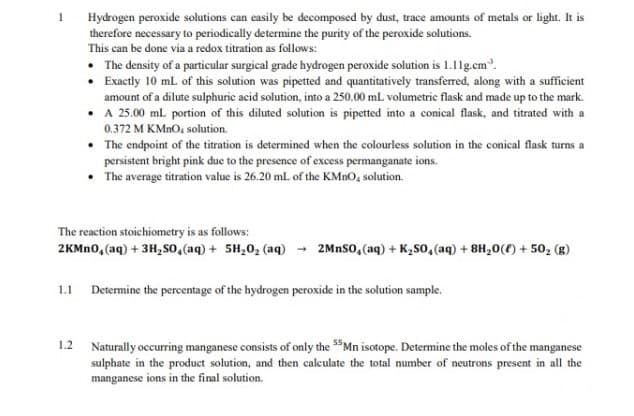Hydrogen peroxide solutions can casily be decomposed by dust, trace amounts of metals or light. It is therefore necessary to periodically determine the purity of the peroxide solutions. This can be done via a redox titration as follows: • The density of a particular surgical grade hydrogen peroxide solution is 1.11g.cm". • Exactly 10 mL of this solution was pipetted and quantitatively transferred, along with a sufficient amount of a dilute sulphuric acid solution, into a 250.00 ml. volumetric flask and made up to the mark. • 25.00 ml portion of this diluted solution is pipetted into a conical flask, and titrated with a 0.372 M KMNO, solution. • The endpoint of the titration is determined when the colourless solution in the conical flask turns a persistent bright pink due to the presence of excess permanganate ions. • The average titration value is 26.20 ml. of the KMNO, solution. The reaction stoichiometry is as follows: 2KMN0, (aq) + 3H,so,(aq) + 5H,0, (aq) - 2MNSO, (aq) + K,s0, (aq) + 8H,0(f) + 50, (B) 1.1 Determine the percentage of the hydrogen peroxide in the solution sample. 1.2 Naturally occurring manganese consists of only the "Mn isotope. Determine the moles of the manganese sulphate in the product solution, and then calculate the total number of neutrons present in all the manganese ions in the final solution.
Hydrogen peroxide solutions can casily be decomposed by dust, trace amounts of metals or light. It is therefore necessary to periodically determine the purity of the peroxide solutions. This can be done via a redox titration as follows: • The density of a particular surgical grade hydrogen peroxide solution is 1.11g.cm". • Exactly 10 mL of this solution was pipetted and quantitatively transferred, along with a sufficient amount of a dilute sulphuric acid solution, into a 250.00 ml. volumetric flask and made up to the mark. • 25.00 ml portion of this diluted solution is pipetted into a conical flask, and titrated with a 0.372 M KMNO, solution. • The endpoint of the titration is determined when the colourless solution in the conical flask turns a persistent bright pink due to the presence of excess permanganate ions. • The average titration value is 26.20 ml. of the KMNO, solution. The reaction stoichiometry is as follows: 2KMN0, (aq) + 3H,so,(aq) + 5H,0, (aq) - 2MNSO, (aq) + K,s0, (aq) + 8H,0(f) + 50, (B) 1.1 Determine the percentage of the hydrogen peroxide in the solution sample. 1.2 Naturally occurring manganese consists of only the "Mn isotope. Determine the moles of the manganese sulphate in the product solution, and then calculate the total number of neutrons present in all the manganese ions in the final solution.
Principles of Modern Chemistry
8th Edition
ISBN:9781305079113
Author:David W. Oxtoby, H. Pat Gillis, Laurie J. Butler
Publisher:David W. Oxtoby, H. Pat Gillis, Laurie J. Butler
Chapter15: Acid–base Equilibria
Section: Chapter Questions
Problem 98AP
Related questions
Question

Transcribed Image Text:Hydrogen peroxide solutions can easily be decomposed by dust, trace amounts of metals or light. It is
therefore necessary to periodically determine the purity of the peroxide solutions.
This can be done via a redox titration as follows:
• The density of a particular surgical grade hydrogen peroxide solution is 1.1lg.cm.
• Exactly 10 ml of this solution was pipetted and quantitatively transferred, along with a sufficient
amount of a dilute sulphuric acid solution, into a 250.00 mL volumetric flask and made up to the mark.
• A 25.00 ml portion of this diluted solution is pipetted into a conical flask, and titrated with a
0.372 M KMNO, solution.
The endpoint of the titration is determined when the colourless solution in the conical flask turns a
persistent bright pink due to the presence of excess permanganate ions.
• The average titration value is 26.20 ml of the KMNO, solution.
The reaction stoichiometry is as follows:
2KMN0, (aq) + 3H, so,(aq) + 5H,0, (aq)
2MnSo, (aq) + K2So, (aq) + 8H,0(f) + 50, (g)
1.1 Determine the percentage of the hydrogen peroxide in the solution sample.
1.2 Naturally occuring manganese consists of only the $"Mn isotope. Determine the moles of the manganese
sulphate in the product solution, and then calculate the total number of neutrons present in all the
manganese ions in the final solution.
Expert Solution
This question has been solved!
Explore an expertly crafted, step-by-step solution for a thorough understanding of key concepts.
Step by step
Solved in 5 steps

Knowledge Booster
Learn more about
Need a deep-dive on the concept behind this application? Look no further. Learn more about this topic, chemistry and related others by exploring similar questions and additional content below.Recommended textbooks for you

Principles of Modern Chemistry
Chemistry
ISBN:
9781305079113
Author:
David W. Oxtoby, H. Pat Gillis, Laurie J. Butler
Publisher:
Cengage Learning

Chemistry: Principles and Reactions
Chemistry
ISBN:
9781305079373
Author:
William L. Masterton, Cecile N. Hurley
Publisher:
Cengage Learning

Chemistry
Chemistry
ISBN:
9781305957404
Author:
Steven S. Zumdahl, Susan A. Zumdahl, Donald J. DeCoste
Publisher:
Cengage Learning

Principles of Modern Chemistry
Chemistry
ISBN:
9781305079113
Author:
David W. Oxtoby, H. Pat Gillis, Laurie J. Butler
Publisher:
Cengage Learning

Chemistry: Principles and Reactions
Chemistry
ISBN:
9781305079373
Author:
William L. Masterton, Cecile N. Hurley
Publisher:
Cengage Learning

Chemistry
Chemistry
ISBN:
9781305957404
Author:
Steven S. Zumdahl, Susan A. Zumdahl, Donald J. DeCoste
Publisher:
Cengage Learning

Chemistry: An Atoms First Approach
Chemistry
ISBN:
9781305079243
Author:
Steven S. Zumdahl, Susan A. Zumdahl
Publisher:
Cengage Learning


Chemistry for Engineering Students
Chemistry
ISBN:
9781337398909
Author:
Lawrence S. Brown, Tom Holme
Publisher:
Cengage Learning